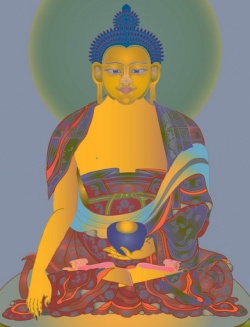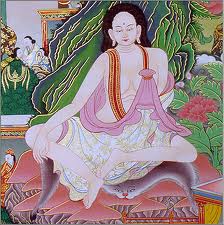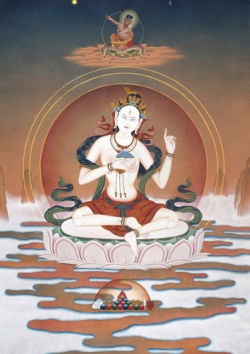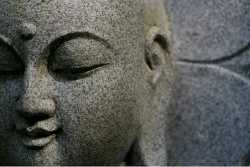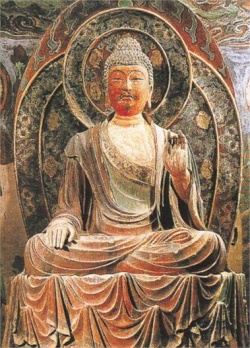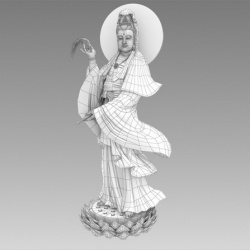Abhidharmakosha Vasubandhu Chapter 8
Abhidharmakosha chapter 8
Chapter 8: aṣṭamaṁ kośasthānam
CHAPTER EIGHT – THE ABSORPTIONS
aṣṭamaṁ kośasthānam oṁ namo buddhāya||
dvidhā dhyānāni catvāri proktāstadupapattayaḥ|
samāpattiḥ śubhaikāgyraṁ pañcaskandhāstu sānugam||1||
The Dhyānas are twofold; The Dhyānas are four in number. The Dhyānas as existence have been defined. Concentration is the application of a pure mind on a single object. With their concomitants, they are the five skandhas.
vicāraprītisukhavat pūrvapūrvāṅgavarjitam|
tathārūpyāḥ catuskandhāḥ adhobhūmivivekajāḥ||2||
The First is filled with vicāra, prīti, and sukha, Parts that the following (Dhyānas) successively abandon. So too, the Ārūpyas. They are made up of four skandhas. It arises out of separation from lower spheres.
vibhūtarūpasaṁjñākhyāḥ saha sāmantakaistribhiḥ|
nārūpye rūpasadbhāvaḥ rūpotpattistu cittataḥ||3||
They are called vibhūtarūpasaṁjñā together with three sāmantakas. There is no rūpa in the Ārūpyas. Physical matter arises from the mind (citta).
ākāśānantyavijñānanatyākiṁcanyasaṁjñakāḥ|
tathāprayogāt māndyāttu nasaṁjñānāpyasaṁjñakaḥ||4||
Ākāśānantya, Vijñānānantya, and Ākiṁcanya are named after their preparatory exercises. Because of its weakness, the (next) absorption is called Neither-Ideas-Nor-Absence of Ideas (nasaṁjñānāpyasaṁjñāka).
iti maulaṁ samāpattidravyamaṣṭavidhaṁ tridhā|
sapta āsvādanavacchuddhānāsravāṇi aṣṭamaṁ dvidhā||5||
There are then eight things that are basic absorptions; The (first) seven are threefold. Enjoyment, pure, and free from the defilements. The eighth is twofold.
āsvādanāsaṁprayuktaṁ satṛṣṇaṁ laukikaṁ śubham|
śuddhakaṁ tattadāsvādyaṁ lokattaramanāsravam||6||
The absorption of enjoyment is associated with thirst; A pure absorption is of a worldly order of good; It is the object of enjoyment. The absorption free from the defilements is transworldly.
pañcādye tarkacārau ca prītisaukhyasamādhayaḥ|
prītyādayaḥ prasādaśca dvitīye'ṅgacatuṣṭayam||7||
There are five parts in the First: Vitarka, vicāra, joy (prīti), happiness (sukha), and samādhi. Four in the Second: faith and joy, etc.
tṛtīye pañca tūpekṣā smṛtiḥ prajñā sukhaṁ sthitiḥ|
catvāryante'sukhāduḥkhopekṣāsmṛtisamādhayaḥ||8||
Five in the Third: equanimity, mindfulness, awareness [saṁprajñāna], happiness, and stability (=samādhi). And four in the last: mindfulness, equanimity, the sensation of neither suffering nor happiness [aduḥkhāsukha], and samādhi.
dravyato daśa caikaṁ ca prasrabdhi sukhamādyayoḥ|
śraddhā prasādaḥ prītistu saumanasyaṁ dvidhāgamāt||9||
Regarded as things, there are eleven parts. In the first two Dhyānas, happiness (sukha) signifies well-being (prasrabdhi). Purity is faith. Joy is satisfaction. This is proved by two texts.
kliṣṭeṣva satprītisukhaṁ prasādaḥ saṁpradhīḥ smṛtiḥ|
upekṣāsmṛtiśuddhiśca kecit prasrabdhyupekṣaṇe||10||
In the defiled Dhyānas there is no joy, happiness, faith, sampradhīḥ (=awareness, saṁprajanya), mindfulness, pure equanimity nor pure mindfulness. According to some, (there is no) well-being and equanimity.
aṣṭāpakṣālamuktatvādāniñjaṁ tu caturthakam|
vitarkacārau śvāsau ca sukhādi ca catuṣṭayam||11||
As it is free from the eight faults, the Fourth is undisturbed. Vitarka and vicāra, the two breaths, and the four of which happiness is the first.
saumanasyasukhopekṣā upekṣāsumanaskate|
sukhopekṣe upekṣā pravido dhyānopapattiṣu||12||
In the dhyāna existences, there is satisfaction, happiness, and equanimity; equanimity and sumanaskatā (=saumanasya, satisfaction); happiness and equanimity; and equanimity.
kāyākṣiśrotravijñānaṁ vijñaptyutthāpakaṁ ca yat|
dvitīyādau tadādyāptaṁ akliṣṭāvyākṛtaṁ ca tat||13||
In the Second Dhyāna and above, the body, eye, and ear consciousness, and the consciousness that sets the act of informing into motion belong to the sphere of the First Dhyāna. These consciousnesses are undefiled-neutral.
atadvān labhate śuddhaṁ vairāgyeṇopapattitaḥ|
anāsravaṁ tu vairāgyāt kliṣṭaṁ hānyupapattitaḥ||14||
One who does not possess them acquires them, pure, through detachment or through birth. One acquires them, undefiled, through detachment. One acquires them, defiled, through falling and through birth.
tṛtīyādyāvadūrdhvādho 'nāsravānantaraṁ śubham|
utpadyate tathā śuddhāt kliṭaṁ cāpi svabhūmikam||15||
After the undefiled, up to the third sphere above or below, there arises the good. The same after the pure, by adding the defiled of its sphere.
kliṣṭāt svaṁ śuddakaṁ kliṣṭaṁ evaṁ cādharaśuddhakam|
cyutau tu śuddhakāt kliṣṭaṁ sarvaṁ kliṣṭāttu nottaram||16||
After the defiled, the pure and the defiled of its sphere. And the pure of a lower sphere. At death, after the pure, the defiled of any types can arise. After the defiled, nothing higher.
caturdhā śuddhakaṁ hānabhāgīyādi yathākramam|
kleśotpattisvabhūmyūrdhvānāsravānuguṇaṁ hi tat||17||
The pure absorption is of four types, of falling, etc. In order, they are suitable to the arising of the defilements, to its own sphere, to a higher sphere, to the undefiled.
dve trīṇi trīṇi caikaṁ ca hāna bhāgādyanantaram|
gatvāgamya dvidhā bhūmīraṣṭau śliṣṭai kalaṅghitāḥ||18||
After the absorption of falling, etc., two, three, three, one. Going and coming in two ways over the eight spheres, in immediate succession, by passing over one sphere, going to the third sphere of a different type, is called “transitional absorption”.
vyutkrāntakasamāpattirvisabhāgatṛtīyagā|
svādhobhūmyāśrayā eva dhyānārūpyāḥ vṛthā'dharam||19||
The dhyāna and ārūpya absorptions have for their support (āśraya) beings of their own spheres or of a lower sphere. A lower absorption has no usefulness.
āryākiṁcanyasāṁmukhyāt bhavāgre tvāsravakṣayaḥ|
satṛṣṇāḥ svabhavālambāḥ dhyānaṁ sadviṣayaṁ śubham||20||
But, in Bhavāgra, it is by entering the Āryan absorption of Ākiṁcanya that one destroys the defilements. Associated with thirst, absorption has its own existence (bhava) for its object. Pure absorption has all that exists for its object.
na maulāḥ kuśalārūpyāḥ sāsravādharagocarāḥ|
anāsraveṇa hīyante kleśāḥ sāmantakena ca||21||
The pure Ārūpya absorptions of the principal spheres do not have lower defiled absorptions for their object. The defilements are abandoned through the undefiled absorptions. And also by means of the sāmantakas, (likewise pure).
aṣṭau sāmantakānyeṣāṁ śuddhāduḥkhāsukhāni hi|
ārya cādyaṁ tridhā kecit atarka dhyānamantaram||22||
There are eight sāmantakas in the basic absorptions. They are pure; they possess the sensation of equanimity. The first is also Āryan. Some say that it is threefold. Dhyānāntara is without vitarka.
tridhā aduḥkhāsukhaṁtacca mahābrahmaphalaṁ ca tat|
savitarkavicāro'dhaḥsamādhiḥ parato'dvayaḥ||23||
To three; It has the sensation of equanimity. It has Mahābrahmā for its result. Up to it, samādhi exists with vitarka and vicāra; Beyond, samādhi exists without either.
ānimittaḥ samākāraiḥ śūnyatānātmaśūnyataḥ|
pravartate apraṇihitaḥ satyākārairataḥ paraiḥ||24||
The absence of characteristics has the aspect of the Tranquil. Emptiness has the aspects of emptiness and non-self. The absence of intention is associated with the other Truths.
śuddhāmalāḥ nirmalāstu te vimokṣamukhatrayam|
śūnyatāśunyatādyākhyāstrayo'parasamādhayaḥ||25||
Pure or immaculate (amala). Immaculate, they are the three gates to deliverance (vimokṣamukha). There are also three other absorptions (samādhi) called “emptiness of emptiness”, etc.
ālambete aśaikṣaṁ dvau śūnyataścāpyanityataḥ|
ānimittānimittastu śāntato'saṁkhyayā kṣayam||26||
The first two refer to the Aśaikṣa under the aspects of emptiness and impermanence. The absence of characteristics in the absence of characteristics has for its object extinction (kṣayam) not attained through conscious effort, and considers it as tranquil (śānta).
sāsravāḥ nṛṣu akopyasya saptasāmantavarjitāḥ|
samādhibhāvanā dhyānaṁ subhamādyaṁ sukhāya hi||27||
Defiled (lit: possessing the defilements, sāsrava). Among humans, Among the Unshakeable Ones. With the exception of the seven sāmantakas. The First good Dhyāna is the cultivation of the absorption that has for its result happiness;
darśanāyākṣyabhijñeṣṭā dhībhedāya prayogajāḥ|
vajropamo'ntye yo dhyāne sāsravakṣayabhāvanā||28||
The supernormal knowledge (abhijñā) of the eye has sight for its result. The cultivation of good arisen from exercise has comprehension for its result. The absorption likened to a Vajra (Vajropamasamadhi) of the Fourth Dhyāna has the extinction of the defilements for its result.
apramāṇāni catvāri vyāpādādivipakṣataḥ|
maitryadveṣaḥ api karuṇā muditā sumanaskatā||29||
The Immeasurables (apramāṇas) are four in number. Because they oppose ill-will, etc., Goodwill is the absence of hatred. So too compassion. Joy is satisfaction.
upekṣā'lobhaḥ ākāraḥ sukhitā duḥkhitā vata|
modantāmiti sattvācca kāmasattvāstu gocaraḥ||30||
Equanimity is the absence of desire. Their aspects are happiness, unhappiness, joy, and beings. They have the living beings of Kāmadhātu for their sphere.
dhyānayormuditā anyāni ṣaṭ su kecittu pañcasu|
na taiḥ prahāṇaṁ nṛṣveva janyante tryanvito dhruvam||31||
Joy in two Dhyānas. The others in six spheres. Or, according to some, in five. There is no abandoning through the Immeasurables. One produces them among humans. He necessarily possesses three.
aṣṭau vimokṣāḥ prathamāvaśubhā dhyānayordvayoḥ|
tṛtīyo'ntye sa cālobhaḥ śubhārūpyāḥ samāhitāḥ||32||
The Deliverances are eight in number. The first two are meditations on loathsome things; They are in two Dhyānas. The Third in the last Dhyāna. It is the absence of desire. They are good Ārūpyas and absorptions.
nirodhastu samāpattiḥ sūkṣmasūkṣmādanantaram|
svaśuddhakādharāryeṇa vyutthānaṁ cetasā tataḥ||33||
The absorption of extinction (nirodhasamāpatti). Immediately after a subtle-subtle mind. Going out into a pure mind of the sphere of the same absorption, or into a lower Āryan mind.
kāmāptadṛśyaviṣayāḥ prathamāḥ ye tvarūpiṇaḥ|
te'nvayajñānapakṣordhvasvabhūduḥkhādigocarāḥ||34||
The first ones have for their object the visible things of Kāmadhātu. As for those that are non-material, all that which belongs to the Knowledge, the Suffering of their sphere and of a higher sphere, etc.
abhibhvāyatanānyaṣṭau dvayamādyavimokṣavat|
dve dvitīyavat anyāni punaḥ śubhavimokṣavat||35||
The Dominant Āyatanas (abhibhvāyatanas) are eight in number. Two are like the First Deliverance. The following two are like the Second. And the last four are like the Third Deliverance.
daśa kṛtsnāni alobhāṣṭau dhyāne'ntye gocaraḥ punaḥ|
kāmāḥ dve śuddhākārūpye svacatuḥskandhagocare||36||
There are ten All-Encompassing Āyatanas (kṛtsnāyatanas). Eight are the absence of desire. They belong to the last Dhyāna. They have Kāmadhātu for their object. Two are pure ārūpya. They have the four skandhas of their sphere for their object.
nirodha uktaḥ vairāgyaprayogāptaṁ tu śeṣitam|
tridhātvāśrayamārūpyasaṁjñaṁ śeṣaṁ manuṣyajam||37||
Extinction has been explained. The others are obtained either through detachment or through cultivation. The qualities of Ārūpyadhātu are obtained by beings of the Three Dhātus; the others, only by humans.
hetukarmabālāddhātvorārupyotpādanaṁ dvayoḥ|
dhyānānāṁ rūpadhātau tu tābhyāṁ dharmatayāpi ca||38||
In two spheres, it is through the power of cause and of action (karma) that one produces the absorption of Ārūpyadhātu. In Rūpadhātu, it is through these two powers, and also be reason of the nature of things, that one produces the dhyānas.
saddharmo dvividhaḥ śāsturāgamādhigamātmakaḥ|
dhātārastasya vaktāraḥ pratipattāra eva ca||39||
The nature of the Good Law of the Master is twofold, āgama and adhigama. Those who preach it and who cultivate it support it.
kāśmīravaibhāṣikanītisiddhaḥ prāyo mayā'yaṁ kathito'bhidharmaḥ|
yaddurguhītaṁ tadihāsmadāgaḥ saddharmanītau munayaḥ pramāṇam||40||
The Abhidharma that is established through the interpretation of the Vaibhāṣikas of Kaśmīr is, in its totality what I have explained. That some ideas, poorly grasped, are reproduced here is our fault, for only the Munis are authoritative (pramāṇa) in the interpretation of the Good Law.
nimīlite śāstari lokacakṣuṣi kṣayaṁ gate sākṣijane ca bhūyasā|
adṛṣṭatattvairniravagrahaiḥ kṛtaṁ kutārkikaiḥ śāsanametadākulam||41||
The Master, the eye of the world, is closed; the witnesses, for the most part, have perished; the Law is put into confusion by persons who have not seen the Truth; and by bad sophists, independent, from whom nothing is gained.
S: Our teacher is no more, of universe the eyes are closed, those who have witnessed him are gone, and troubled by false reasoning is our religion!
gate'tha śāntiṁ paramāṁ svayaṁbhuvi svayaṁbhuvaḥ śāsanadhūrdhareṣu ca|
jagatyanāthe gaṇaghātibhirmataiḥ niraṅkuśaiḥ svairamihādya caryate||42||
For he who knows for himself has departed on the Supreme Path, as well as the supports of the Law of the one who knows for himself: the world no longer has a Protector. The defilements, which destroy spiritual qualities, now have full liberty.
S: For the supreme lord has entered final repose, followed by those faithfully this holy doctrine have maintained. The world is left without a guide. Unchecked corruption nowadays is freely spreading and defeating virtue.
iti kaṇṭhagataprāṇaṁ viditvā śāsanaṁ muneḥ|
balakālaṁ malānāṁ ca na pramādyaṁ mumukṣubhiḥ||43||
Seeing that the Law of the Muni is in its last breath, and that it is the hour of the forces of the defilements, those who desire liberation should be diligent.
S: The times are come when flooded by the rising tide of ignorance buddha’s religion seems to breathe its last! Therefore, if for salvation you do care, do not be heedless!
|'bhidharmakośe samāpattinirderśo nāmāṣṭamakośasthānamiti||
Bhasya: ―This concludes the Eighth Chapter of the Abhidharmakosabhasyam, entitled “Instruction in the Absorptions”.

